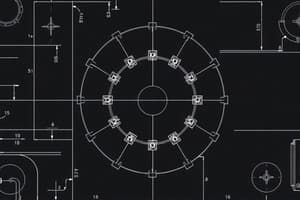Podcast
Questions and Answers
What does matchline accuracy refer to in the context of engineering?
What does matchline accuracy refer to in the context of engineering?
- The addition of general notes to clarify design intent
- The verification of missing information on engineering drawings
- The quality control of spelling accuracy
- The precision of surfaces aligning on mating parts (correct)
How can matchline accuracy be verified?
How can matchline accuracy be verified?
- Proofreading and editing for spelling mistakes
- Adding assembly instructions and material recommendations
- Visual inspection, measured distances, or coordinate measuring machines (correct)
- Checking for completeness and clarity in engineering drawings
Why is spelling quality control important in engineering drawings?
Why is spelling quality control important in engineering drawings?
- To highlight specific requirements for testing procedures
- To clarify the design intent and add context
- To avoid misunderstandings and misinterpretations (correct)
- To ensure the drawings are complete and clear
What can compromised effectiveness in conveying design intent and functional requirements on engineering drawings?
What can compromised effectiveness in conveying design intent and functional requirements on engineering drawings?
Which of the following is NOT a method used to verify matchline accuracy?
Which of the following is NOT a method used to verify matchline accuracy?
Why are general notes added to engineering drawings?
Why are general notes added to engineering drawings?
Which of the following is NOT a key aspect of annotation standards?
Which of the following is NOT a key aspect of annotation standards?
What is the primary purpose of dimensional accuracy in engineering?
What is the primary purpose of dimensional accuracy in engineering?
Which of the following is NOT a common method for measuring dimensional accuracy?
Which of the following is NOT a common method for measuring dimensional accuracy?
What is the primary purpose of geometry verification?
What is the primary purpose of geometry verification?
Which of the following is NOT a factor that annotation standards aim to address?
Which of the following is NOT a factor that annotation standards aim to address?
What is the purpose of laser scanning techniques in dimensional accuracy measurement?
What is the purpose of laser scanning techniques in dimensional accuracy measurement?
Study Notes
Annotation Standards
Annotation standards refer to the set of guidelines or rules governing the placement, formatting, and appearance of annotations on engineering drawings. They aim to ensure clarity, precision, and consistency in the communication of design specifications, dimensions, tolerances, and materials. Key aspects of annotation standards include the use of standard symbols, units, notation, layout, and presentation conventions. Proper implementation of annotation standards helps to reduce confusion and errors and facilitates accurate interpretation of engineering drawings.
Dimensional Accuracy
Dimensional accuracy refers to the degree to which the dimensions of a part conform to their specified values. It is essential for ensuring that a part functions correctly and fits properly in its intended application. Dimensional accuracy is determined through measurement and comparison against the part's design specifications. Common methods of measuring dimensional accuracy include gauging, dial indicators, coordinate measuring machines (CMMs), and laser scanning techniques.
Geometry Verification
Geometry verification involves checking the shapes, angles, and alignment of features on a part against its design specifications. This process ensures that the part is manufactured according to the original intentions of the designer. Geometry verification can involve visually inspecting the part, comparing digital models to physical measurements, or using specialized software to analyze the part's geometry.
Matchline Accuracy
Matchline accuracy refers to the precision with which two or more surfaces on a part align with each other. This is particularly important in the context of mating parts where accurate matchline alignment is essential for proper fit and function. Matchline accuracy can be verified through methods such as visual inspection, measured distances, or the use of specialized metrology equipment like coordinate measuring machines (CMMs).
Spelling
Quality control of engineering drawings should also consider spelling accuracy to maintain clear and unambiguous communication. Errors in spelling can lead to misunderstandings and misinterpretation of the drawing's contents. Careful proofreading and editing should be performed to ensure that all labels, descriptions, and comments are free of spelling mistakes.
Missing Information
Missing information on engineering drawings can compromise their effectiveness in conveying design intent and functional requirements. It is essential to thoroughly review drawings for completeness and to ensure that all necessary details are included. Examples of missing information might include incomplete or unclear part names, missing or ambiguous dimensions, absent or incorrect tolerances, and insufficient labeling of features.
General Notes
General notes are additional information or explanations that are added to engineering drawings to clarify the design intent, provide context, or highlight specific requirements. Including clear and concise general notes can help to eliminate potential sources of confusion and ambiguity. Examples of general notes might include assembly instructions, material recommendations, testing procedures, or regulatory compliance information.
Studying That Suits You
Use AI to generate personalized quizzes and flashcards to suit your learning preferences.
Description
Test your knowledge on annotation standards, dimensional accuracy, geometry verification, matchline accuracy, spelling, missing information, and general notes in engineering drawings. Explore key concepts and best practices for clear communication and accuracy in design specifications.



